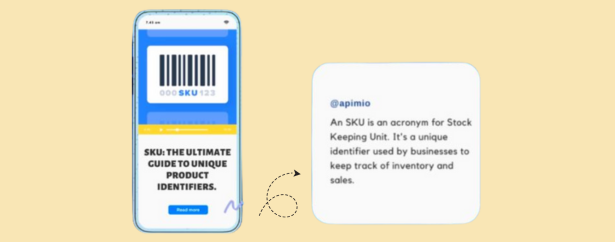The last thing a brand wants is to be associated with a product recall. But in today’s world, it’s not just about the quality of the product itself. It’s also about how you label and identify your products. Luckily, SKU solves this issue for you.
Being an eCommerce manager, you might be aware of this term already, but what you might be unaware of is the science behind it.
In this blog, we will be discussing SKU in-depth and going through its definition, purpose, working, benefits, and finally, the difference between an SKU and UPC.
What is a Stock Keeping Unit?
An SKU is an acronym for Stock Keeping Unit. It’s a unique identifier used by businesses to keep track of inventory and sales. Without a tracking system like this, it would be nigh impossible to know what items we’re selling and how much inventory was available at any given time.
The definition of SKU varies depending on the context in which it is used. For example, if you are working with Amazon, and Amazon Product ID (or ASINWhat is ASIN ASIN or Amazon Standard Identification Number is a 10-character set used by retailers to track inventory. The ASIN number is unique and it... More) would be your SKU.
Guidelines for a Good SKU
You can generate your own SKUs if the products you buy from your suppliers don’t have them or if you make your own. To hide your supply chain, you may also wish to generate customer-facing SKUs—even if your suppliers provide you with SKUs. This is especially useful if you’re in a price war with other online shops that use different pricing schemes.
- Keep them brief. So that the identical data fits in all systems, an SKU must be 32 characters or less.
- Make them stand out. Reusing SKUs from prior seasons is not a good idea.
- A zero should never be used to begin an SKU. When working with SKUs in Excel, the first character is dropped if it is a zero, which presents issues.
- Avoid characters with uncertain meanings. I, L, and O are letters that are commonly confused for numbers.
- Do not mix them up with other identifiers, such as model numbers.
- Keep it simple. Stick to numbers and big characters with dashes or dots as separators. Also, avoid spaces and slashes, as some systems have trouble with them.
Get ahead of the competition! Subscribe now to learn the top secrets of eCommerce success
Sign up to our page to be the first to find out the top secrets, tips, and tricks throughout the week. So what are you waiting for? Subscribe today!

How to Set up an SKU
Step 1: Choose an SKU Identifier
It’s crucial to keep in mind what you want to track before setting your SKU numbers. As previously said, each business is unique, so each SKU number will represent distinct product attributes or characteristics. Depending on your business kind, below are some popular SKU number identifiers to consider:
- Store location
- Product department
- Manufacturer/brand of the product
- Feature of the Product
- Size
- Color
- Style
- Type
- Product subcategory
Explore how Apimio PIM can reduce your Product information worries
What are you waiting for? Create and manage your multiple SKUS through our PIM.

You should consider the amount of your inventory when selecting SKU number identifiers for your firm. You may not need to add product subcategories or product characteristics in your Stock Keeping Unit if you have a modest volume of inventory. However, if you have a lot of inventory, you’ll probably need more sophisticated SKU numbers to keep track of everything.
Moreover, customers are another factor to consider when choosing SKU number identifiers. If customers commonly inquire about a certain brand of product, make sure to include a brand identifier in your SKU number.
Step 2: Generate a Top-level Identifier
Let’s get down to business and create the SKU number. Keep in mind that the SKU number should be at least eight characters long but no longer than twelve.
Your top-level identification should be two to three characters long. This is the highest-level category in which your product can be classified. If your product is a golf club and your company is a sports goods store, the first two to three characters would correspond to the golf department.
If you have multiple retail locations, on the other hand, it can make sense to utilize your top-level identifier to define each one.
Step 3: Pick out More Unique Product Traits
The next two to eight characters in your SKU number should be utilized to indicate more distinct product characteristics like size, color, brand, or style. Some firms prefer to use letters rather than numbers to identify suppliers in order to minimize confusion.
Step 4: Finish With a Sequential Number
Your SKU number’s last two to three characters should be a sequential number. This entails assigning a number to each stop-keeping unit in order to ensure that it is distinct and to distinguish between newer and older inventories in your product line.
For example, if you have two gowns in your store that are both from the same source and are the same size, color, and style, the sequential number will tell you which is which.
Example of Setting Up an SKU
Let’s proceed through the process of creating an SKU number for a series of products now that you know how they’re made. Let’s pretend you run a clothing department shop and decide to allocate SKU identifiers in the following manner:
BRAND
| Brand | Identifier |
| Nike | NK |
| Calvin Klein | CK |
| Ralph Lauren | RL |
CATEGORY
| Category | Identifier |
| Shirt | 01 |
| Sweater | 02 |
| Jacket | 03 |
| Pants | 04 |
COLOR
| Color | Identifier |
| Blue | 11 |
| Green | 12 |
| Red | 13 |
| Grey | 14 |
| Brown | 15 |
SIZE
| Size | Identifier |
| Small | 21 |
| Medium | 22 |
| Large | 23 |
Considering these SKU Identifiers, an SKU for Blue Calvin Klein Jacket in small size would be:
CK031121
Benefits of SKU

Track Inventory
As you know, the process of managing inventory can be highly complex. There are many things to keep track of, including the cost, quantity, per-item values, and stock levels. It is not uncommon for a business to use multiple software applications to manage its inventory.
SKU has simplified all aspects of inventory management for over 30,000 businesses in 80+ countries.
With an SKU system, you can easily see if you are running low on any product. This is especially helpful if you are running a business that requires you to maintain a certain amount of stock of each item for sale.
Identify Shrinkage
Undetected shrinkage is a significant issue in retail. In-store shrinkage is estimated to cost retailers $44 billion annually in the U.S. alone. The problem can be very challenging and time-consuming to track and minimize.
Inventory classification with SKUs allows for transparency in stock movements and aids in determining where and how the product goes missing, reducing the risk of theft.
Identify Profits
In order to make an informed decision about how many products to stock and which items to promote on your website, you first need to understand how many products your customers want and what they want.
By using SKUs to manage product variants, you may report not only on the primary product line but also on each specific product variation, such as color, size, and material. These reports can assist you in figuring out which product variants are the most significant sellers and which ones aren’t.
This not only lets you see your primary profit streams more clearly, but it also helps you make strategic product selections to help your firm expand.
Refill Inventory
SKU refilling is a procedure where a new product is sold with its empty container. It is just like buying a soft drink can and then taking it to the store to buy the soda. In this way, you would have saved money, but you would have also saved time since you wouldn’t have to walk from the store to your home again to get the soda and then bring it back to the store.
Refilling products work similarly. You can buy items like shampoos, toothpaste, and other hygiene products at lower prices than those of the same products.
For a small business owner, manually handling vast quantities of inventory might be challenging. The quantity of on-hand products is easily ascertained by adding an SKU to each product variation. Then, threshold limits and reorder points can be defined for each product, indicating when a new purchase order is required.
Inventory management with SKUs allows you to keep better track of your inventory levels, reorder just when necessary, and reduce inventory holding expenses.
Difference between SKU and UPC

The SKU and UPC are both necessary codes for almost any product sold to a retail store. The difference is pretty simple, but it’s an important distinction that can have a big impact on how products are tracked and purchased.
A UPC is a 12-digit barcode that uniquely identifies a product. It was designed to be scanned at a speed of 100 scans per second by a laser scanner and could only encode numbers. The first digit represented the type of item, followed by a manufacturer’s code. This meant that each manufacturer had its interpretation of the individual digits.
In contrast, an SKU (Stock Keeping Unit) is an alphanumeric identifier for products sold in retail stores. In many cases, it replaces the UPC as it is cheaper to print up and therefore more popular with retailers.
Moreover, UPC is a universal code whereas, SKU is an internal code and does not match the same product of a different company.
Lastly, UPC is a numeric code and contains numbers only, whereas SKU is an alphanumeric code containing both alphabets and numbers.
Conclusion
If you want to make sure that the products in your store are sold under the correct SKU, it’s essential to know what they are and why you need them. Now that you are more familiar with the term SKU and its qualities and benefits, it’s time to implement and start using SKUs for all your products.
If you have any questions, don’t hesitate to reach out by visiting our website today!



